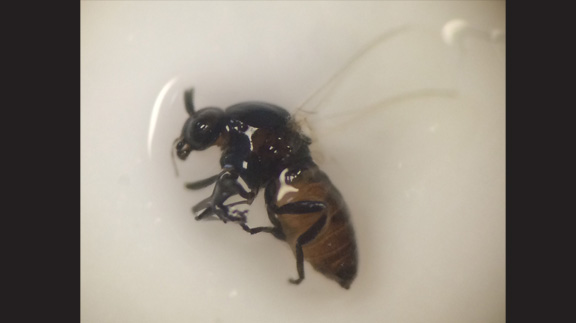Farm & Ranch
[AgriLife Today] Agrilife Extension expert :Conditions right for black flies

By: Adam Russell
- By: Adam Russell, 903-834-6191, [email protected]
- Contact: Sonja Swiger, 254-968-4144, [email protected]
STEPHENVILLE – Reports of black flies are increasing as recent rains created favorable conditions for the swarming, biting pest, according to Dr. Sonja Swiger, Texas A&M AgriLife Extension Service entomologist, Stephenville.
Black flies aren’t like run-of-the-mill house flies or other biting flies, such as horn or stable flies, Swiger said. They’re tiny, powerful blood-feeders who aren’t picky about their host. They attack humans as readily as domesticated animals and wildlife, and feed at various times throughout the day.
“They’re nasty biters,” she said. “They’ll attack anything with blood but they prefer animals.”
Swiger said she has received a higher number of calls about black flies this year and suspects spring rains have created perfect breeding grounds for the pest. A mild spring may have also provided better conditions for the temperature-dependent fly, which usually is active throughout the summer.
Black flies are especially problematic in northern and eastern Texas where water is plentiful, but the rains may expand their habitat, she said.
One recent case in East Texas involved the loss of more than a dozen adolescent chickens, according to the caller, Swiger said.
Black flies have been known to kill animals by sucking blood or suffocation from clogging or covering up airways, she said. The flies also carry diseases. Black flies’ flight patterns are dependent upon the wind, light, temperature and host availability.
Swiger said as with any pest it’s better to deal with black flies by addressing them before they reach adulthood, but the flies’ breeding habitat makes it difficult to kill eggs and larvae.
Eggs and larvae stick together in flowing water, such as creeks, attached to vegetation or rocks. Immature black flies can live in habitats ranging from trickling water to rivers.
Bacillus thuringiensis israelensis products, which are better known for controlling mosquitoes, can be used to kill black flies in the larval stage.
Black flies lay between 100-600 eggs, so one hatching could pose problems to a landowner because they grow together and move in swarms once they reach adulthood, she said. Several generations can reach adulthood each year.
“They’re not easy to find, but if you have a running creek nearby or have had a problem with them in the past you might see them again this year,” she said. “Target areas around vegetation and rocks in flowing water.”
Swiger said repellants with diethyl-meta-toluamide or DEET, are supposed to be effective against them but added that female black flies are determined feeders once they find a potential host. Permethrin can be applied to animals to repel and kill black flies, she said. Dabs of petroleum jelly around the sensitive areas of animals, such as the nose, ears and eyes, can prevent bites and the pest from congregating.
“The fact that they are fully aquatic and their habitat is flowing water can make them tricky to deal with but it might be worth looking,” she said.
For more information about black flies and other insects and pests, visit http://livestockvetento.tamu.edu.
-30-
Find more stories, photos, videos and audio at http://today.agrilife.org
Farm & Ranch
Hazards of Backyard Poultry

By Barry Whitworth, DVM
Having backyard poultry is a popular agriculture enterprise. According to the United States Department of Agriculture, 0.8 percent of all households in the United States have chickens. People keep chickens for a variety of reasons with table eggs being one of the more common reasons.
Unfortunately, some of these poultry producers are not aware of the hazards that come with keeping poultry because many times they carry pathogens but appear healthy.
Chickens are carriers of several zoonotic diseases. These are diseases that can be passed from animals to humans. According to a recent survey in Pennsylvania, a majority of backyard poultry producers were aware of the dangers of avian influenza. However, this study also revealed that far fewer producers were aware of the risk of possible exposure to Salmonella and Campylobacter.
The lack of knowledge about the hazards of raising poultry likely contributes to the continued issues of Salmonella outbreaks associated with backyard poultry. In 2023, the Centers for Disease Control and Prevention reported 1,072 illnesses of Salmonella linked to backyard poultry, and 272 of those patients required hospitalization. Oklahoma reported 43 individuals with the disease.
To read more, pick up a copy of the April issue of NTFR magazine. To subscribe by mail, call 940-872-5922.
Farm & Ranch
Ag Elsewhere: Wyoming

By Tressa Lawrence
Babies are tucked away in every nook and cranny. Many ranchers across Wyoming have baby animals popping up all over this time of year.
Farm & Ranch
Ag Elsewhere: Montana

By Lindsey Monk
Another load of grain in to keep feeding the calves until the green grass can really start popping.
-

 Country Lifestyles1 year ago
Country Lifestyles1 year agoScott & Stacey Schumacher: A Growth Mindset
-

 Equine7 months ago
Equine7 months agoThe Will to Win
-

 Country Lifestyles7 years ago
Country Lifestyles7 years agoStyle Your Profile – What your style cowboy hat says about you and new trends in 2017
-

 Country Lifestyles4 years ago
Country Lifestyles4 years agoAmber Crawford, Breakaway Roper
-

 HOME7 years ago
HOME7 years agoGrazing North Texas – Wilman Lovegrass
-

 Country Lifestyles7 years ago
Country Lifestyles7 years agoDecember 2016 Profile, Rusty Riddle – The Riddle Way
-

 Country Lifestyles8 years ago
Country Lifestyles8 years agoJune 2016 Profile – The man behind the mic: Bob Tallman
-

 Outdoor9 years ago
Outdoor9 years agoButtercup or Primrose?






